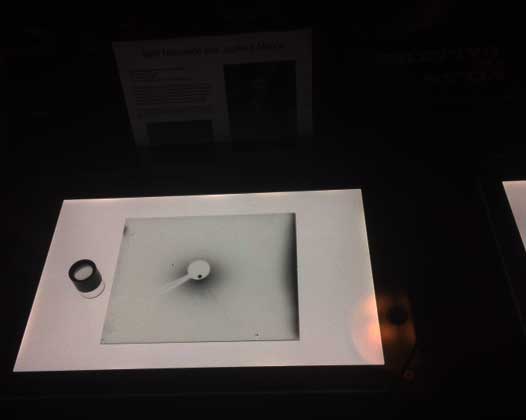Greetings from (offsite) Palmia
Observatory
Resident Astronomer George is
offsite this week at the Carnegie Observatory open house. I had not
attended the open house before and it was quite interesting to walk on the
grounds and down the halls and sit in the library where the great observers
thought and pondered the images taken at Mt. Wilson. Check out this photo taken
in the library
with the portrait of George Hale looking out the crowd.
There is a picture with some of the big observers who visited Mt. Wilson and had discussions here in the library and it was neat to think of Einstein and others lounging about here discussing astronomy. Another exhibit that I particularly liked was one of the original glass plates, taken in about 1925, showing Jupiter and moons. The text in the photo is not clearly legible but it describes who and when this image was taken and how the blurry tail across Jupiter was made as part of the attempt to dim the light from Jupiter so the moons would be more visible. I can easily image some early astronomer using the little magnifying glass to examine and find some distant object.
The open house included several lectures and a tour of the machine shop where special fixtures were designed and built for various Carnegie Observatory facilities including the new telescope in Chile. Visitors enjoyed the pleasant surroundings and of course ice cream, which was the treat of the day. I also had a chance to visit with Math Whiz, Dave and Sister, Pam, and with Retired Legacy Coder, Now Studying Physics Full time, Larry. There were a couple of folks I might have seen before from OPT or maybe San Diego Astronomy Club there as well and I thought I spied OCA Don Lynn in the distance also.
I've spent part of my time in
Pasadena attending AAS/DPS conference sessions on comets and new findings.
Previously, I was much more interested in cosmology and hadn't spent much
time about new solar system findings, but some of the photos of comets, up close
by spacecraft is really fascinating. Consider the odd shaped comet,
67P/CG. I was fascinated by a talk about the orbit insertion of the
Rosetta spacecraft around the comet. Normally, an orbit around a large
spherical planet is well defined, but orbit around an irregularly shaped
object, an object that is rotating and changing directions because of
intermittent jets of material escaping from the comet, introduces all sorts of
perturbations and causes the spacecraft to speed up and slowdown in difficult
ways to predict. Just look at this image of 67P/CG and try to imagine how
you would continuously calculate what the line of sight gravitational
attraction would be like. It's amazing to me that you can even find a
stable orbit.
Resident Astronomer George
with the portrait of George Hale looking out the crowd.
 |
| Open House at Carnegie Observatory with George Hale overlooking the Library |
 |
| Original glass plate at the Carnegie Observatory showing Jupiter and moons |
 |
| Carnegie Observatory in Pasadena Open House |
Well after leaving the open house it
was off to the convention center for the American Astronomical Society Division
of Planetary Science (AAS/DPS) meeting. You will remember from the last post
about the need to understand the characteristics of your camera and analysis
software and how you don't want to get fooled into seeing something in your
image that is really just an artifact and not a real astronomical object.
Well at the meeting many sessions and much of each speakers time dealt
with a lot of these very same concerns. The professionals were always
second guessing what could be going wrong with their data pipelines and how the
statistics of random and systematic errors might cause them to err. It
seems that many months of effort by many professionals are spent trying to
increase the robustness of their data pipelines in fodder to prevent false
positives. I'm at least glad that my simple types of problems, although
they do require diligence in analyzing the data and images, is nowhere near as
complex as these other projects.
 |
| Comet 67P (Courtesy Wikipedia) |
One final item, I received an email
alert from AAVSO that described the new novae, just discovered on October 14,
as a magnitude 10.9 object. Hey, that object should be visible in my
camera, even in the city lights view here at the observatory. Wow, I was
quite excited about planning to go out and try to find this object when I
return from the AAS conference here in Pasadena. Oops, then I saw the RA
and Dec for this nova and with Dec= -73 degrees, it is not going to be
observable here in the northern hemisphere. It's located in the Small
Magellanic Cloud. Darn, that is a disappointment. I just have to keep
waiting for the next novae that I can practice on and see if I can find it too.
Until next time,Resident Astronomer George
If you are interested in things astronomical or in astrophysics and cosmology
Check out this blog at www.palmiaobservatory.com

No comments:
Post a Comment